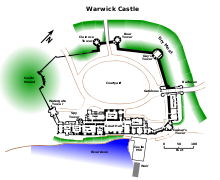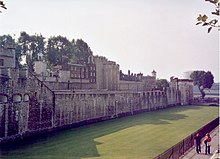Castles of England/English Castle Design
This module describes the defensive elements of a castle's design.
Design Overview[edit | edit source]

The plan of Warwick Castle shows the majority of defensive features that will be covered in this chapter.
The Barbican[edit | edit source]

The barbican was developed during the 13th century as a way of improving the defence of the gate - the most vulnerable part of a castle. The theory underlying the design was to force the attackers to enter an enclosed space, overlooked by well protected positions, in order to approach the gate. Once inside the enclosed space (usually a narrow passage) the attackers could be harried by arrows, boiling water or other weapons fired from elevated positions. The passage inside the barbican was sometimes designed with a dog-leg close to the gate. This prevented attackers being able to effectively use a battering ram.
The name derives from the Iranian word 'parivraka' meaning 'protective'.
Concentric Walls[edit | edit source]

Concentric walls were developed at a similar time to the barbican and were based on the same theory. A second wall was built outside of the main wall. The area between the two walls became a killing zone for attackers who climbed the outer wall - once they were between the two walls they could be fired on from the inner wall, with no opportunity to take cover or move out of range. The outer wall was lower than the inner wall, allowing defenders on the inner wall to fire at attackers outside the outer wall.
The cost of a concentric wall was enormous and they were only used on the most important castles. The main examples being Dover and the Tower of London.
Ditches, Moats and Drawbridges[edit | edit source]
The first defence of the castle was usually the ditch and rampart. In early castle construction, a ditch was often dug around the site and the spoil piled up on the inside, forming a rampart. In later designs, the ditch was retained although the rampart was replaced with a stone wall.

To make the ditch difficult to cross, a moat was created by diverting a local water source to fill the ditch to a depth greater than a man could wade. The moat also made it more difficult to undermine the outer walls (see below).
Walls, Battlements and Fighting Platforms[edit | edit source]
Wall Construction[edit | edit source]
A curtain wall (so called because it seems to hang like a curtain between the towers) was usually between 30 and 45 feet high and between six and 20 feet thick; the wall becoming, in general, higher and thicker over time in response to improved offensive weapons and more advanced construction techniques. Early curtain walls were constructed of wood using the heaviest manageable timber that was available locally. The timber was driven to a relatively shallow depth in the ground and then strengthened with cross timbers and propped from behind to resist battering. Timber walls were vulnerable to attack by fire and were replaced with stone as castle design evolved. By the late 11th century nearly all curtain walls were being constructed from stone. Stone walls were also vulnerable to fire as extreme heat can cause cracking and heaving.
The height of the curtain wall increased in response to developments in siege equipment, the more modern designs being capable of pitching projectiles over the lower walls. However, as the wall height increased, so did the weight and the stability was reduced. This reduced stability made the base of the wall vulnerable to breaching and undermining. The danger of breaching was mitigated to a degree by building a thicker sloped base to the wall (called a batter).
Every castle wall, regardless of its height or width, is a massive and extremely heavy constructions and must be well founded on rock or other firm material. If the ground was not strong enough to support the walls, then large trenches would need to be dug and filled with rubble in a similar manner to modern building foundations. The wall was then raised on the foundations or bedrock. The most typical construction was to build a shell of stone slabs, each cut to a regular shape, then fill the shell with a compacted rubble core. Once complete, the wall would be topped with a parapet and then plastered to protect it from weathering.
Undermining[edit | edit source]
One way of breaching a castle wall was to tunnel beneath it. Miners would dig beneath the walls, propping the walls above as they went with wooden supports. Once enough of the wall was undermined and propped, the wood would be set alight. As the tunnel collapsed, the wall would fall into the hole, hopefully making a gap large enough for the attackers to break through. Examples of castles that were attacked by undermining include Dover Castle and Rochester Castle. Clearly the usefulness of undermining as an offensive technique depended to a large degree on the founding of the walls. Walls founded on hard rock, for example granite, would present a significant challenge for miners.
Arrow and Gun Loops[edit | edit source]

Originally, arrows were of little use when defending a castle as they could not easily penetrate the chain mail armour worn by attackers. The crossbow, a much more powerful weapon, was able to pierce armour and had a greater range than the ordinary bow. With this development, castles began to be built with arrow loops. These were usually built so that defenders could fire down at attackers near the base of walls or other vulnerable points. Arrow loops were designed with a funnel shape, with a wide opening tapering down to a narrow slit. This gave archers a sideways range in their aim while being well protected.
The later development of the gun lead to a modification of the design of loops to accommodate it. Gun loops are usually only present in the gatehouse.
Gates and Portcullis[edit | edit source]

Castle gates were usually constructed of wood, reinforced with iron bars. It is likely that they would have been of very heavy construction, however, few original gates survive so the exact methods of construction are not entirely certain. The gate was usually backed by a wooden bar that slotted into holes in the wall to brace it closed. Despite their strength and bracing the gate remained the most vulnerable part of any well designed castles. Stronger castles had a gatehouse to enable the defenders to engage enemies attempting to break down the gate.
A portcullis is a metal grille that was lowered down in front of a gate when the castle was under attack. The portcullis protected the gate both from battering and from fires. Once lowered, the portcullis was usually jammed from above to prevent it being lifted. In some castles, the portcullis was designed to be lowered behind attackers, trapping them in a passageway in which they could be attacked from either murder holes or arrow loops. Large or sophisticated castles could have a whole series of portcullis through the gate passages.